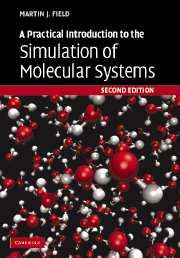Book contents
- Frontmatter
- Contents
- Preface to the first edition
- Preface to the second edition
- 1 Preliminaries
- 2 Chemical models and representations
- 3 Coordinates and coordinate manipulations
- 4 Quantum chemical models
- 5 Molecular mechanics
- 6 Hybrid potentials
- 7 Finding stationary points and reaction paths on potential energy surfaces
- 8 Normal mode analysis
- 9 Molecular dynamics simulations I
- 10 More on non-bonding interactions
- 11 Molecular dynamics simulations II
- 12 Monte Carlo simulations
- Appendix 1 The pDynamo library
- Appendix 2 Mathematical appendix
- Appendix 3 Solvent boxes and solvated molecules
- Bibliography
- Author index
- Subject index
Preface to the first edition
Published online by Cambridge University Press: 03 December 2009
- Frontmatter
- Contents
- Preface to the first edition
- Preface to the second edition
- 1 Preliminaries
- 2 Chemical models and representations
- 3 Coordinates and coordinate manipulations
- 4 Quantum chemical models
- 5 Molecular mechanics
- 6 Hybrid potentials
- 7 Finding stationary points and reaction paths on potential energy surfaces
- 8 Normal mode analysis
- 9 Molecular dynamics simulations I
- 10 More on non-bonding interactions
- 11 Molecular dynamics simulations II
- 12 Monte Carlo simulations
- Appendix 1 The pDynamo library
- Appendix 2 Mathematical appendix
- Appendix 3 Solvent boxes and solvated molecules
- Bibliography
- Author index
- Subject index
Summary
The reason that I have written this book is simple. It is the book that I would have liked to have had when I was learning how to carry out simulations of complex molecular systems. There was certainly no lack of information about the theory behind the simulations but this was widely dispersed in the literature and I often discovered it only long after I needed it. Equally frustrating, the programs to which I had access were often poorly documented, sometimes not at all, and so they were difficult to use unless the people who had written them were available and preferably in the office next door! The situation has improved somewhat since then (the 1980s) with the publication of some excellent monographs but these are primarily directed at simple systems, such as liquids or Lennard-Jones fluids, and do not address many of the problems that are specific to larger molecules.
My goal has been to provide a practical introduction to the simulation of molecules using molecular mechanical potentials. After reading the book, readers should have a reasonably complete understanding of how such simulations are performed, how the programs that perform them work and, most importantly, how the example programs presented in the text can be tailored to perform other types of calculation. The book is an introduction aimed at advanced undergraduates, graduate students and confirmed researchers who are newcomers to the field. It does not purport to cover comprehensively the entire range of molecular simulation techniques, a task that would be difficult in 300 or so pages.
Information
- Type
- Chapter
- Information
- Publisher: Cambridge University PressPrint publication year: 2007
